Q-Jet Carb Base Gasket Tech Info: The "Hot Slot" Manifold Problem
#1
Tech Contributor
Thread Starter
Member Since: Aug 1999
Location: At my Bar drinking and wrenching in Lafayette Colorado
Posts: 13,653
Received 4,922 Likes
on
1,929 Posts

Q-Jet Carb Base Gasket Info for “Hot Slot” Manifolds
by Lars Grimsrud
©2019 Lars Grimsrud.
A common mistake when installing a Q-Jet on a 1966-1970 GM V8 is that the “mechanic” uses a 1971 – 1980 carb base gasket. This results in severe exhaust gas ingestion into the intake manifold, external exhaust leaks on the driver’s side of the carb base, and possible carb base damage and engine damage from detonation.
Early Rochester QuadraJet Carburetor installations (1966-1969) often used a “hot slot” exhaust groove that runs from side-to-side in the intake manifold just forward of the primary throttle bores, popularly known as the “smiley face” manifolds. The purpose of this “smiley face hot slot” was to run hot exhaust gasses under the carb to provide fuel pre-heat on cold days. The hot gasses would heat up a stainless steel plate, and the carb was bolted directly to this stainless plate for good heat transfer. Chevy used this design on ’66-’68 327/300hp, ’68 327/350hp, and ’66-’69 427/390hp Corvette engines, and Pontiac used it on their '67 4-barrel engines.
There are several problems with this arrangement:
1. A hot carb with hot fuel may run very well on cold mornings in Minnesota, but this arrangement does not run well on hot summer nights in Southern California.
2. A carb bolted directly to a steel shield is highly prone to vacuum leaks between the carb and the shield.
3. Any leak in the gasket arrangement results in exhaust gas ingestion directly into the intake manifold, which leads to poor engine performance and the possibility of engine damage if the leak becomes severe.
4. Since the “hot slot” was only used for a few years, there is a high probability of “mechanics” installing the incorrect carb base gasket (late model style), resulting in exhaust gas ingestion into the manifold and external exhaust leaks due to the incorrectly-fitting late-model base gasket.
To solve this problem, you need to use a special 3-piece carb base gasket “kit” for the “hot slot” manifolds. There are no parts stores who recognize the existence of such a gasket kit, so you have to create your own (I am no longer offering these for sale).
Here is a typical cast iron Chevy “hot slot” “smiley face” manifold. The slot was also used on the aluminum Chevy Big Block manifolds, ’66-’68 327, and on 1967 Pontiacs. The “hot slot” is the long groove running from side to side just forward of the small primary throttle bores.
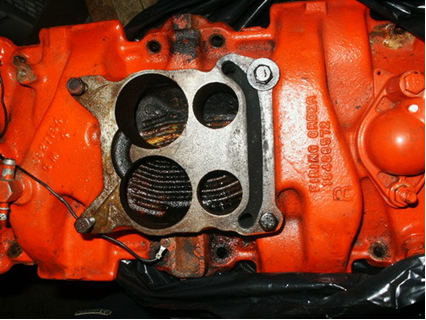
Here is the “hot slot” on the aluminum Chevy Big Block. On this manifold, you can see the exhaust gas ingestion path into the manifold due to the failure to use the correct base gasket – the bottom of the carb has been exposed directly to the exhaust gas, and this has gone through the intake manifold:
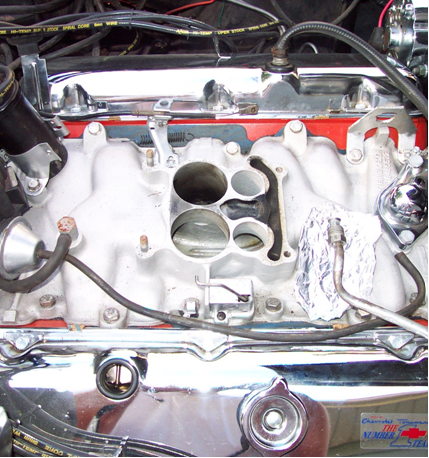
Here is the fix for the “hot slot” exhaust gas problem. In the stock configuration, you must first use a high-temperature composite gasket which lies directly on the intake manifold. Notice that it is not symmetrical – if you install it upside-down, you will get a massive exhaust leak on the driver’s side of the manifold:
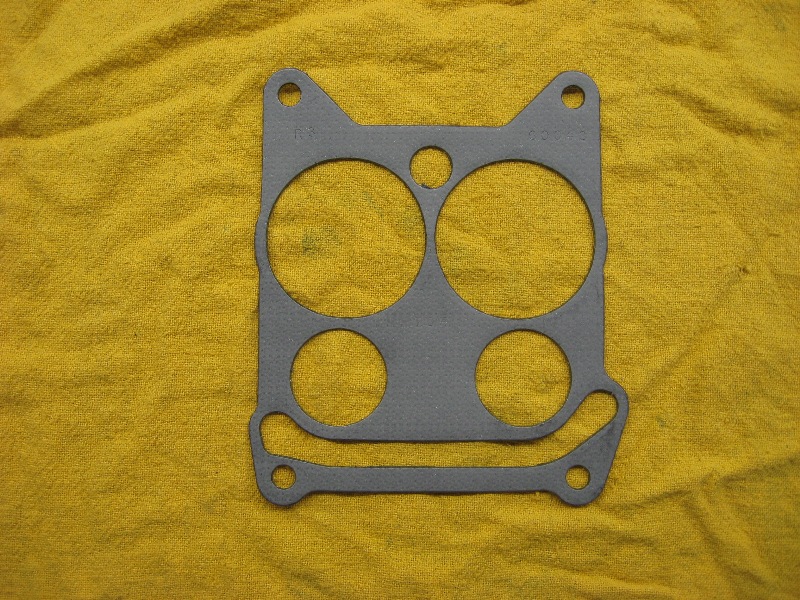
Next, and placed on top of the high-temp composite gasket, is the stainless steel shield. The factory gasket “kit” ends at this point by installing the carb directly on top of this steel plate. This results in the entire bottom of the carb being heated up to the temperature of the exhaust gas, and the setup is highly prone to vacuum leaks:
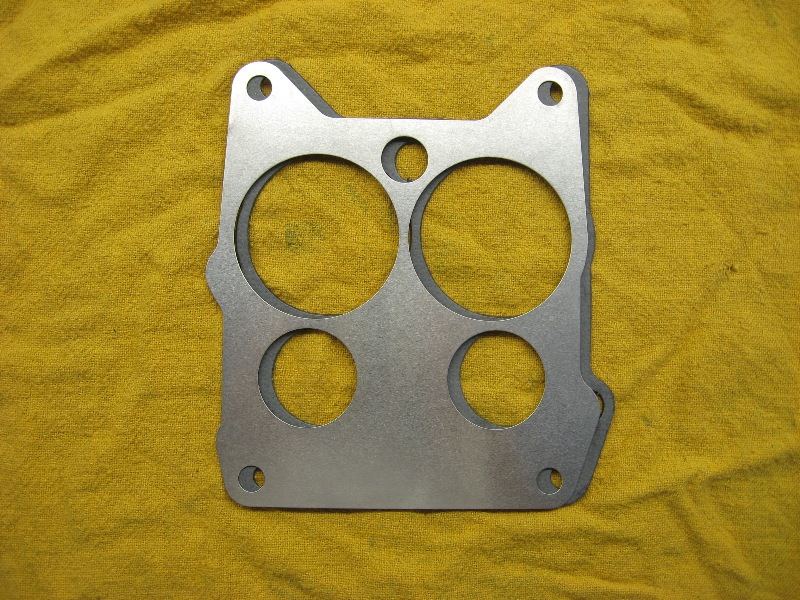
To solve the problems associated with the hot carb, I add a third gasket on top of the stainless shield. This gasket has the same shape as the shield (note “bulge” on driver’s side) to prevent any exhaust leaks out the driver’s side of the manifold, and the gasket keeps the majority of the heat off the bottom of the carb:
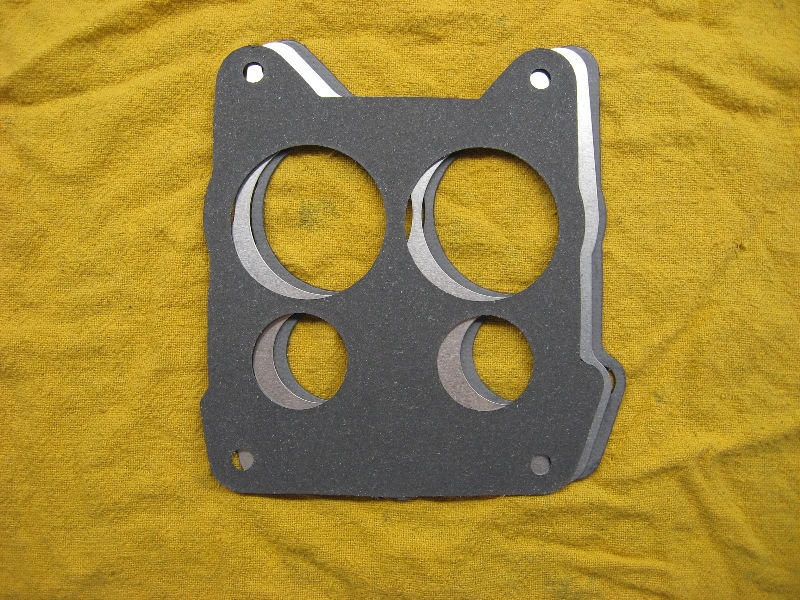
The complete gasket kit looks like this:
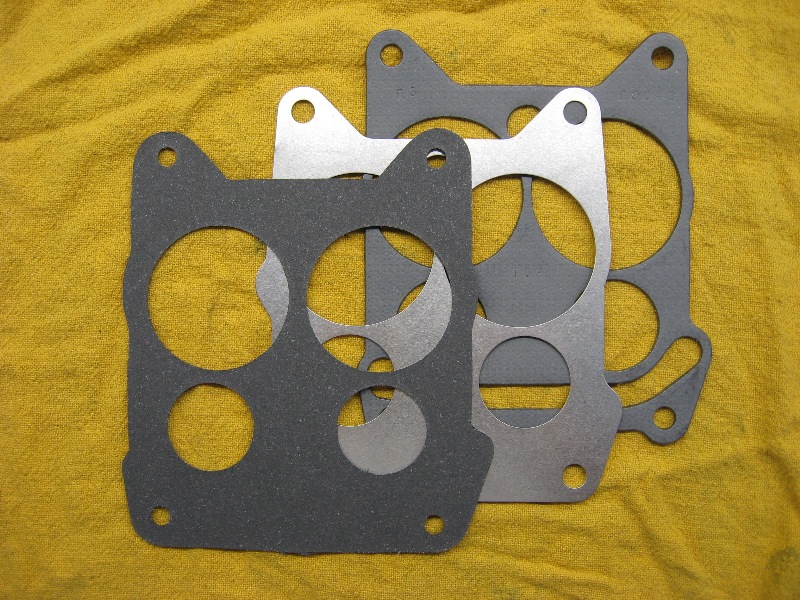
This kit eliminates any exhaust leaks into the manifold as well as any external exhaust leaks. It also keeps the carb base significantly cooler than the stock setup, making the carb installation very similar to the 1971-1980 style installation (which did not use the “hot slot.”)
I am no longer offering these kits for sale, but you can build your own using the following part numbers and sources:
1. Bottom gasket (high temp with forward groove): Felpro 60043 (available from any NAPA store or Summit Racing)
2. Middle gasket (stainless steel heat shield): Felpro 60731 (available from any NAPA store or Summit Racing)
3. Top gasket (4-hole without groove): Mr. Gasket 56 or 56C (available from Summit Racing. Most NAPA stores will order Mr. Gasket parts for you)
Lars
by Lars Grimsrud
©2019 Lars Grimsrud.
A common mistake when installing a Q-Jet on a 1966-1970 GM V8 is that the “mechanic” uses a 1971 – 1980 carb base gasket. This results in severe exhaust gas ingestion into the intake manifold, external exhaust leaks on the driver’s side of the carb base, and possible carb base damage and engine damage from detonation.
Early Rochester QuadraJet Carburetor installations (1966-1969) often used a “hot slot” exhaust groove that runs from side-to-side in the intake manifold just forward of the primary throttle bores, popularly known as the “smiley face” manifolds. The purpose of this “smiley face hot slot” was to run hot exhaust gasses under the carb to provide fuel pre-heat on cold days. The hot gasses would heat up a stainless steel plate, and the carb was bolted directly to this stainless plate for good heat transfer. Chevy used this design on ’66-’68 327/300hp, ’68 327/350hp, and ’66-’69 427/390hp Corvette engines, and Pontiac used it on their '67 4-barrel engines.
There are several problems with this arrangement:
1. A hot carb with hot fuel may run very well on cold mornings in Minnesota, but this arrangement does not run well on hot summer nights in Southern California.
2. A carb bolted directly to a steel shield is highly prone to vacuum leaks between the carb and the shield.
3. Any leak in the gasket arrangement results in exhaust gas ingestion directly into the intake manifold, which leads to poor engine performance and the possibility of engine damage if the leak becomes severe.
4. Since the “hot slot” was only used for a few years, there is a high probability of “mechanics” installing the incorrect carb base gasket (late model style), resulting in exhaust gas ingestion into the manifold and external exhaust leaks due to the incorrectly-fitting late-model base gasket.
To solve this problem, you need to use a special 3-piece carb base gasket “kit” for the “hot slot” manifolds. There are no parts stores who recognize the existence of such a gasket kit, so you have to create your own (I am no longer offering these for sale).
Here is a typical cast iron Chevy “hot slot” “smiley face” manifold. The slot was also used on the aluminum Chevy Big Block manifolds, ’66-’68 327, and on 1967 Pontiacs. The “hot slot” is the long groove running from side to side just forward of the small primary throttle bores.

Here is the “hot slot” on the aluminum Chevy Big Block. On this manifold, you can see the exhaust gas ingestion path into the manifold due to the failure to use the correct base gasket – the bottom of the carb has been exposed directly to the exhaust gas, and this has gone through the intake manifold:

Here is the fix for the “hot slot” exhaust gas problem. In the stock configuration, you must first use a high-temperature composite gasket which lies directly on the intake manifold. Notice that it is not symmetrical – if you install it upside-down, you will get a massive exhaust leak on the driver’s side of the manifold:

Next, and placed on top of the high-temp composite gasket, is the stainless steel shield. The factory gasket “kit” ends at this point by installing the carb directly on top of this steel plate. This results in the entire bottom of the carb being heated up to the temperature of the exhaust gas, and the setup is highly prone to vacuum leaks:

To solve the problems associated with the hot carb, I add a third gasket on top of the stainless shield. This gasket has the same shape as the shield (note “bulge” on driver’s side) to prevent any exhaust leaks out the driver’s side of the manifold, and the gasket keeps the majority of the heat off the bottom of the carb:

The complete gasket kit looks like this:

This kit eliminates any exhaust leaks into the manifold as well as any external exhaust leaks. It also keeps the carb base significantly cooler than the stock setup, making the carb installation very similar to the 1971-1980 style installation (which did not use the “hot slot.”)
I am no longer offering these kits for sale, but you can build your own using the following part numbers and sources:
1. Bottom gasket (high temp with forward groove): Felpro 60043 (available from any NAPA store or Summit Racing)
2. Middle gasket (stainless steel heat shield): Felpro 60731 (available from any NAPA store or Summit Racing)
3. Top gasket (4-hole without groove): Mr. Gasket 56 or 56C (available from Summit Racing. Most NAPA stores will order Mr. Gasket parts for you)
Lars
Last edited by lars; 06-08-2019 at 04:41 PM.
The following 5 users liked this post by lars:
C2Scho (11-03-2019),
dmaxx3500 (07-29-2018),
Hud1086 (01-04-2017),
JC_ (07-06-2019),
marshal135 (04-28-2018)
#2
12.14 w/ the original 327

Lars, thanks for the tip. Glad to see you're back and posting again. Hope you're doing well.
Wes
Wes
#3
Race Director



Member Since: Mar 2001
Location: Mustang OK
Posts: 13,846
Received 3,766 Likes
on
1,669 Posts
2023 C1 of the Year Finalist - Modified
2015 C1 of the Year Finalist

On ALLLLLLLLLLLLL Q-jet manifolds that I have, or have used in the past, as well as for a few other people, I plug these holes! For me, Its worth a little slugishness when cold to just totally eliminate this problem. I use a pipe thread tap and go fairly deep into the holes on each side. Then I install pipe plugs with a hex hole using an Allen wrench. I liberally apply sealant to the threads of the pipe plug. ALLLLLLLLLLLLLL of my cars are 4sp, so its no problem for me to feather the clutch and throttle as needed until the engine warms up a little (I HATE fighting this stuff in a car with an auto tranny!!!).
#4
Team Owner



Member Since: Oct 2000
Location: Washington Michigan
Posts: 38,899
Received 1,856 Likes
on
1,099 Posts

In spite of the stainless baffle plate, the heat from direct impingement of the hot exhaust gases in the “hot-slot” can eventually overheat the carburetor baseplate, causing warpage, cracking or distortion which can render the baseplate useless; this design was abandoned by GM after 1969, as it contributed to failure of the soft plugs in the bottom of Q-Jet float bowls, which resulted in the biggest carburetor recall in GM history for engine fires.
This troublesome “hot-slot” design was used on the iron intakes on ’66-’68 327/300hp, ’68 327/350hp, and ’66-’69 427/390hp Corvette engines.


#6
Melting Slicks


#7
#8
Race Director


Member Since: Jan 2000
Location: Corsicana, Tx
Posts: 12,603
Received 1,874 Likes
on
912 Posts
2020 C2 of the Year - Modified Winner
2020 Corvette of the Year (performance mods)
C2 of Year Winner (performance mods) 2019
2017 C2 of Year Finalist

Good stuff as always Lars. I remember many years ago when working on daily drivers that used that setup..it was VERY common to get one brought in on Monday morning after someone did a carb rebuild at home. Often the stainless plate was left out and you could hear it coming long before it got there!
JIM
JIM
#9
Team Owner



Member Since: Oct 2000
Location: Washington Michigan
Posts: 38,899
Received 1,856 Likes
on
1,099 Posts


#10
Tech Contributor
Thread Starter
Member Since: Aug 1999
Location: At my Bar drinking and wrenching in Lafayette Colorado
Posts: 13,653
Received 4,922 Likes
on
1,929 Posts

Wow - that was a resurrection of a 6-year-old thread, and my original posted article was grossly outdated. Since this thread has been revamped, I have updated the original post with the current version of the article, which includes all the part numbers and sources.
Lars

Lars
#11
Team Owner



Typical example of the consequences of the wrong gasket setup...
Last edited by Frankie the Fink; 09-08-2014 at 06:32 AM.
#12
Here's my 3461S before and after I repaired it with J&B weld.
It's held up very well.
Also, pictures of my 1967 300hp intake manifold hot slot.
It's held up very well.
Also, pictures of my 1967 300hp intake manifold hot slot.
#13
Pro


Q-Jet Carb Base Gasket Info for “Hot Slot” Manifolds
Early Rochester QuadraJet Carburetor installations (1966-1969) often used a “hot slot” exhaust groove that runs from side-to-side in the intake manifold just forward of the primary throttle bores, popularly known as the “smiley face” manifolds. The purpose of this “smiley face hot slot” was to run hot exhaust gasses under the carb to provide fuel pre-heat on cold days. The hot gasses would heat up a stainless steel plate, and the carb was bolted directly to this stainless plate for good heat transfer. Chevy used this design on ’66-’68 327/300hp, ’68 327/350hp, and ’66-’69 427/390hp Corvette engines, and Pontiac used it on their '67 4-barrel
1. Bottom gasket (high temp with forward groove): Felpro 60043 (available from any NAPA store)
2. Middle gasket (stainless steel heat shield): Felpro 60731 (available from any NAPA store)
3. Top gasket (4-hole without groove): Mr. Gasket 4256G (available from Summit Racing)
Lars
Early Rochester QuadraJet Carburetor installations (1966-1969) often used a “hot slot” exhaust groove that runs from side-to-side in the intake manifold just forward of the primary throttle bores, popularly known as the “smiley face” manifolds. The purpose of this “smiley face hot slot” was to run hot exhaust gasses under the carb to provide fuel pre-heat on cold days. The hot gasses would heat up a stainless steel plate, and the carb was bolted directly to this stainless plate for good heat transfer. Chevy used this design on ’66-’68 327/300hp, ’68 327/350hp, and ’66-’69 427/390hp Corvette engines, and Pontiac used it on their '67 4-barrel
1. Bottom gasket (high temp with forward groove): Felpro 60043 (available from any NAPA store)
2. Middle gasket (stainless steel heat shield): Felpro 60731 (available from any NAPA store)
3. Top gasket (4-hole without groove): Mr. Gasket 4256G (available from Summit Racing)
Lars
Lars talks about the Quadrajet applications. My 66 uses the Holley 4150. Are the above part numbers correct for a Holley?
Randy
#14
Tech Contributor
Thread Starter
Member Since: Aug 1999
Location: At my Bar drinking and wrenching in Lafayette Colorado
Posts: 13,653
Received 4,922 Likes
on
1,929 Posts

No, you cannot use Q-Jet gaskets on a Holley or AFB.
This original thread was originally posted on the C3 Forum, and was re-posted here on the C1/C2 Forum as general info for the members since a lot of C2s have been converted over to Q-Jets. A lot of members here on C2 also own 1st generation Camaros, which use Q-Jets with hot slot manifolds. No factory C2 Vettes were ever equipped with Q-Jets, but used similar manifold systems with the Holley and AFB carbs.
Lars
This original thread was originally posted on the C3 Forum, and was re-posted here on the C1/C2 Forum as general info for the members since a lot of C2s have been converted over to Q-Jets. A lot of members here on C2 also own 1st generation Camaros, which use Q-Jets with hot slot manifolds. No factory C2 Vettes were ever equipped with Q-Jets, but used similar manifold systems with the Holley and AFB carbs.
Lars
#15
Q-Jet Carb Base Gasket Info for “Hot Slot” Manifolds
I am no longer offering these kits for sale, but you can build your own using the following part numbers and sources:
1. Bottom gasket (high temp with forward groove): Felpro 60043 (available from any NAPA store)
2. Middle gasket (stainless steel heat shield): Felpro 60731 (available from any NAPA store)
3. Top gasket (4-hole without groove): Mr. Gasket 4256G (available from Summit Racing)
Lars
I am no longer offering these kits for sale, but you can build your own using the following part numbers and sources:
1. Bottom gasket (high temp with forward groove): Felpro 60043 (available from any NAPA store)
2. Middle gasket (stainless steel heat shield): Felpro 60731 (available from any NAPA store)
3. Top gasket (4-hole without groove): Mr. Gasket 4256G (available from Summit Racing)
Lars
Summit online help sent me simple search list that included nearly everything they sell (thanks for nothing). After going thru their list I found this one: http://www.summitracing.com/parts/mrg-56c/overview/
that looked like the closest match.
Has anyone else found a suitable replacement for the 4256G? Will the 56C work as well? Can't find a description of what the 4256G was made of but the 56C is described as Nitrile Rubber Composite .063 in. thick.
thanks,
#16
Still have the package from Advanced auto purchase its a Felpro. Check out the attached image. hope that helps.
I am rebuilding a 1968 L79 for my 1967 Camaro and found this thread. My engine has the Hot Slot manifold, so went to buy the recommended gaskets. The Mr Gasket 4256G is no longer available according to every parts store I've asked and can't find any online either.
Summit online help sent me simple search list that included nearly everything they sell (thanks for nothing). After going thru their list I found this one: http://www.summitracing.com/parts/mrg-56c/overview/
that looked like the closest match.
Has anyone else found a suitable replacement for the 4256G? Will the 56C work as well? Can't find a description of what the 4256G was made of but the 56C is described as Nitrile Rubber Composite .063 in. thick.
thanks,
Summit online help sent me simple search list that included nearly everything they sell (thanks for nothing). After going thru their list I found this one: http://www.summitracing.com/parts/mrg-56c/overview/
that looked like the closest match.
Has anyone else found a suitable replacement for the 4256G? Will the 56C work as well? Can't find a description of what the 4256G was made of but the 56C is described as Nitrile Rubber Composite .063 in. thick.
thanks,
#17
Team Owner



Member Since: Oct 2000
Location: Washington Michigan
Posts: 38,899
Received 1,856 Likes
on
1,099 Posts

I am rebuilding a 1968 L79 for my 1967 Camaro and found this thread. My engine has the Hot Slot manifold, so went to buy the recommended gaskets. The Mr Gasket 4256G is no longer available according to every parts store I've asked and can't find any online either.
Summit online help sent me simple search list that included nearly everything they sell (thanks for nothing). After going thru their list I found this one: http://www.summitracing.com/parts/mrg-56c/overview/
that looked like the closest match.
Has anyone else found a suitable replacement for the 4256G? Will the 56C work as well? Can't find a description of what the 4256G was made of but the 56C is described as Nitrile Rubber Composite .063 in. thick.
thanks,
Summit online help sent me simple search list that included nearly everything they sell (thanks for nothing). After going thru their list I found this one: http://www.summitracing.com/parts/mrg-56c/overview/
that looked like the closest match.
Has anyone else found a suitable replacement for the 4256G? Will the 56C work as well? Can't find a description of what the 4256G was made of but the 56C is described as Nitrile Rubber Composite .063 in. thick.
thanks,

#18
Pro


Randy
#19
Where does this exhaust gas come from? assuming that the intake only has a connection to the intake side of the heads, I don't understand where the exhaust comes from.
I have a 1969 350 that came without an original intake. I purchased an intake (69 350) that has the hot slot. and purchased a 69 QuadraJet. Did I receive a wrong part? Can it still be used with the above mentioned method for sealing off the port (either with the proper gaskets or with plugs)?
I have a 1969 350 that came without an original intake. I purchased an intake (69 350) that has the hot slot. and purchased a 69 QuadraJet. Did I receive a wrong part? Can it still be used with the above mentioned method for sealing off the port (either with the proper gaskets or with plugs)?
#20
Safety Car



Member Since: Apr 2013
Location: Arlington TX
Posts: 4,832
Received 929 Likes
on
531 Posts
2023 Restomod of the Year Finalist
2023 C1 of the Year Finalist - Unmodified

Where does this exhaust gas come from? assuming that the intake only has a connection to the intake side of the heads, I don't understand where the exhaust comes from.
I have a 1969 350 that came without an original intake. I purchased an intake (69 350) that has the hot slot. and purchased a 69 QuadraJet. Did I receive a wrong part? Can it still be used with the above mentioned method for sealing off the port (either with the proper gaskets or with plugs)?
I have a 1969 350 that came without an original intake. I purchased an intake (69 350) that has the hot slot. and purchased a 69 QuadraJet. Did I receive a wrong part? Can it still be used with the above mentioned method for sealing off the port (either with the proper gaskets or with plugs)?




